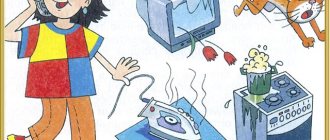Basics of proper swimming in various styles
Regardless of the age at which the skill is mastered, it is important to know: the correct body position is horizontal with the face lowered into the water . It is instinctive for a person to raise his head. But a lowered face helps maintain balance and prevents the cervical vertebrae from overworking during prolonged exposure to water.
This position increases buoyancy and increases speed in any style. Therefore, when you learn “from scratch”, it is better to immediately develop the correct position, so as not to waste time and effort on relearning.
Sports swimming has 4 styles:
- Butterfly . This style is not suitable for children who are just learning. It requires great physical effort and well-functioning coordination of actions. During the movement, the swimmer “flies” over the water, making simultaneous swings of his arms and a splash of his legs, similar to the movements of a dolphin.
- Breaststroke. The arms perform wide, “spreading” movements, and the legs seem to push off from the surface of the water.
- Crawl on the chest. The fastest style: the arms make sweeping strokes, and the legs perform alternating scissor-type swings. Most of the time the swimmer's face is submerged in the water. In this case, inhalation occurs while turning the head.
- Back crawl. The movements are identical to the previous style, only the swimmer is on his back. This is a clear advantage for children who are not comfortable putting their face in the water.
If you are not raising a professional athlete, you should not immediately accustom him to a particular style. First of all, you need to practice breathing, leg and arm work.
How to teach a child to swim?
If you practice every day, it is quite possible to achieve the desired result during a week-long vacation. There are even express methods developed by experienced instructors that allow you to master basic movements within one or two days. The most important thing here is not to force things and focus on the degree of readiness of your ward.
The learning process also depends on what you want to get as a result: whether you just need to teach your child to stay afloat or immediately master the desired style. If you are inclined to the second option, professional swimmers recommend starting with the crawl.
Naturally, when selecting exercises, it is important to focus on the student’s age. Next, we will consider basic techniques that correspond to age-related physiological and psychological characteristics.
Swimming training for preschool children
It is impossible to force a small, but already human, to swim without desire, and it does not make sense. At the age of 3-4 years, a child learns about the world through play. Therefore, in a playful way, you can instill in your baby the main skills, and the swimming technique will be practiced as he grows up.
We bring to your attention several exercises that will help you master the necessary movements:
- "Mill". Starting position: standing in chest-deep water, arms bent. You need to perform circular movements with your hands, immersing them as you lower them into the water. Here it is important to emphasize the correct order of immersion: first of all, the hands come into contact with the water, then the forearms, elbows, and shoulders.
- "Scissors". This task focuses on footwork. Holding the side or bottom with your hands (at shallow depths), the child will need to lie down on the water and alternately swing his legs up and down.
- "Jellyfish". Holding the student under the chest, ask him to lie face down in the water. The neck, legs and arms are as relaxed as possible. This position teaches you to stay afloat and not be afraid to dip your face.
- "Starfish". The body position is similar to the previous one, only the arms and legs are extended to the sides. You can complicate the task by adding exhalation into the water. If the child is not ready to lie face down, you can start the exercise from a supine position.
- "Heart". Starting position: standing, arms extended forward. Ask your child to “draw” a heart by spreading his arms to the side and bringing them together at the bottom. Shoulders and arms should be immersed in water.
- "Frog". The child holds onto the adult with his hands, moving his legs as if pushing off the water.
- "Jumping" in the water. Invite your baby to sit down and then jump, doing the previous two exercises at the same time. Be prepared to provide physical assistance (hold, catch) and psychological support to the beginning swimmer.
- "Float" . Starting position: standing. Take a deep breath and, squatting, sink to the bottom. Tell them in advance that you will need to hold your breath. As an incentive to perform, you can put some bright toy on the bottom.
Such training will help you get comfortable in the water and not cry if drops get into your eyes or nose. You can use protective equipment: glasses, a hat and other accessories to create maximum comfort for your child.
If you present training as a fun time with parents, the child will look forward to new exciting activities. By the way, such exercises provide a good psychoprophylactic effect and allow you to relieve muscle and emotional tension.
“Academic” methodology for teaching primary school children
The period from 7 to 10 years is characterized by awareness in performing exercises. There is no longer any need to invent exciting activities in a playful way. The younger student is ready to learn to swim on his own initiative. Of course, parents should not forget that motivation at this age still depends on external factors. Therefore, as with children, it is important to create an atmosphere that stimulates activities, arouses interest and brings positive emotions. Use praise often and avoid ridicule.
Now let's move on to practice. Step-by-step implementation of the exercises described below is a guarantee that the child will learn to swim:
- Breathing into the water. Starting position: standing, immersing your face in the water, hands holding the handrails. In this case, you need to exhale air through your nose or mouth until a “boil” forms. Such exercises are done 10 to 15 times before starting training.
- Swimming with a board . Starting position: lying on the water, holding the board. Arms extended. The face is lowered into the water. Moving forward is carried out due to the movement of the legs. The legs work from the hip without bending at the knee. It is important to follow the breathing technique here: to inhale, lift your face up, exhale into the water. Mastering swimming with a board can take from one to several lessons, depending on your student’s readiness.
- "Arrow" . The exercise is similar to the previous one, but is performed without a board. This task is a kind of test: if the child has coped with it, then it is worth moving on to the next stage.
- Connecting hands. There may be three options:
- if the leg movements were performed in the breaststroke style, then the arm movements are performed in the same style. You will receive a “ready” breaststroke, all that remains is to hone your skills;
- if the legs moved with the crawl, “breaststroke” movements with the arms are allowed. In this case, the child will master the “doggy style” technique, which is intuitive and allowed at the initial stages;
- and the third option: legs when swimming - crawl, hand strokes - also crawl. With parallel training in sideways breathing, the child will fully master this style.
Of course, it’s too early to talk about the ideal performance technique at this stage. But the child already knows how to float on the surface of the water and move forward.
Teaching your child to swim before traveling? Be calm about him not only in the water, but also on land. To prevent your child from getting lost in a strange place, download the “Where are my children” application with the Surround Sound and GPS function from the AppStore and GooglePlay stores.
“Express option” for younger students
If you think the above method is too complicated or time-consuming (especially when summer is in full swing and you want to teach your child to swim freely in a matter of days), try another way. It will allow you to achieve results in a short time, without focusing on practicing the technique.
The essence of the classes comes down to several exercises:
- Starting position: lying on the water, hands resting on the bottom. Immerse your face in water 10 times and relax your neck muscles. Naturally, the exercise can only be performed at shallow depths.
- Perform the same actions with one hand lifted from the bottom of the pool.
- Perform the same actions with alternately lifting your hands off the bottom.
When the child has mastered the third task, ask him to remove both hands at once. In this way he will learn to “lie” on the water. But that's only half the story. Next you should teach him to move forward. You can do this using the following exercises:
- Starting position: lying on the water, smoothly straighten your arms forward. Remember that haste and jerking are of no use here.
- While on the water with your arms outstretched, push off the side with your feet and “slide” forward. When this is achieved, we add movements with the legs (just move them without focusing on the technique of execution). Having mastered moving with the legs, we also connect the arms without reference to the style. Let the child move them the way he feels comfortable. The only requirement: do not put your hands behind your body so that you can raise your face above the water without losing balance.
- Raising your head. At first, you should raise your head without inhaling. It is important to work out the sequence of actions. When this happens, add an inhale over the water.
This method was proposed by coach D. Tarakanov. The author claims that the desired result can be achieved in just one lesson.
Middle and high school age
You can train a teenager using the methods outlined above. After 12 years of age, it is easier for children to complete the tasks described; they easily learn the instructions. Difficulties that arise during learning, most often, can be caused by psychological issues:
- strong fear of water (as a result of unsuccessful attempts to swim earlier);
- lack of contact with the “teacher”;
- persistent reluctance to learn.
Here the adult needs to find an approach to the older student, motivate him to acquire new skills, and demonstrate the benefits of swimming. Once a trusting relationship has been established, you can begin training.





